| dc.contributor.author | Ossareh, Hamid R. | |
| dc.contributor.author | Ventura, Alejandra C. | |
| dc.contributor.author | Merajver, Sofia D. | |
| dc.contributor.author | Del Vecchio, Domitilla | |
| dc.date.accessioned | 2014-05-02T16:40:01Z | |
| dc.date.available | 2014-05-02T16:40:01Z | |
| dc.date.issued | 2011-04 | |
| dc.date.submitted | 2010-11 | |
| dc.identifier.issn | 00063495 | |
| dc.identifier.issn | 1542-0086 | |
| dc.identifier.uri | http://hdl.handle.net/1721.1/86371 | |
| dc.description.abstract | Signaling pathways consisting of phosphorylation/dephosphorylation cycles with no explicit feedback allow signals to propagate not only from upstream to downstream but also from downstream to upstream due to retroactivity at the interconnection between phosphorylation/dephosphorylation cycles. However, the extent to which a downstream perturbation can propagate upstream in a signaling cascade and the parameters that affect this propagation are presently unknown. Here, we determine the downstream-to-upstream steady-state gain at each stage of the signaling cascade as a function of the cascade parameters. This gain can be made smaller than 1 (attenuation) by sufficiently fast kinase rates compared to the phosphatase rates and/or by sufficiently large Michaelis-Menten constants and sufficiently low amounts of total stage protein. Numerical studies performed on sets of biologically relevant parameters indicated that ~50% of these parameters could give rise to amplification of the downstream perturbation at some stage in a three-stage cascade. In an n-stage cascade, the percentage of parameters that lead to an overall attenuation from the last stage to the first stage monotonically increases with the cascade length n and reaches 100% for cascades of length at least 6. | en_US |
| dc.description.sponsorship | United States. Air Force Office of Scientific Research (Grant FA9550-09-1-0211) | en_US |
| dc.language.iso | en_US | |
| dc.publisher | Elsevier | en_US |
| dc.relation.isversionof | http://dx.doi.org/10.1016/j.bpj.2011.02.014 | en_US |
| dc.rights | Article is made available in accordance with the publisher's policy and may be subject to US copyright law. Please refer to the publisher's site for terms of use. | en_US |
| dc.source | Elsevier Open Archive | en_US |
| dc.title | Long Signaling Cascades Tend to Attenuate Retroactivity | en_US |
| dc.type | Article | en_US |
| dc.identifier.citation | Ossareh, Hamid R., Alejandra C. Ventura, Sofia D. Merajver, and Domitilla Del Vecchio. “Long Signaling Cascades Tend to Attenuate Retroactivity.” Biophysical Journal 100, no. 7 (April 2011): 1617–1626. © 2011 Biophysical Society | en_US |
| dc.contributor.department | Massachusetts Institute of Technology. Department of Mechanical Engineering | en_US |
| dc.contributor.mitauthor | Del Vecchio, Domitilla | en_US |
| dc.relation.journal | Biophysical Journal | en_US |
| dc.eprint.version | Final published version | en_US |
| dc.type.uri | http://purl.org/eprint/type/JournalArticle | en_US |
| eprint.status | http://purl.org/eprint/status/PeerReviewed | en_US |
| dspace.orderedauthors | Ossareh, Hamid R.; Ventura, Alejandra C.; Merajver, Sofia D.; Del Vecchio, Domitilla | en_US |
| dc.identifier.orcid | https://orcid.org/0000-0001-6472-8576 | |
| mit.license | PUBLISHER_POLICY | en_US |
| mit.metadata.status | Complete | |
